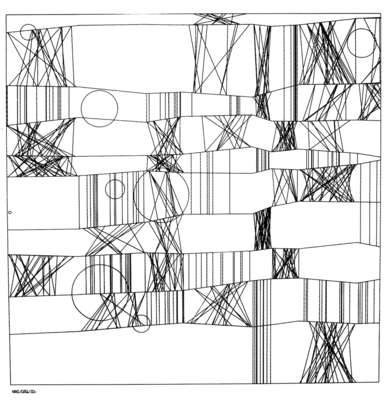This drawing is one of the most often cited in books and articles about the earliest phase of computer art (mid-1960s). It may be called an icon of the pioneering times of the digital art movement.
It is not known precisely how many exemplars may exist of this drawing in the form of orginally produced by the automatic drawing machine. Nake estimates that he generated about 30 or 40 copies during the years from 1965 to 1967. Each one of these must be considered an original work. He also did an edition of high-quality silkscreen prints (40 copies, 1966). Additionally, about five silkscreen prints exist on heavy colored paper.
When generating this image, Nake says, he was inspired by Paul Klee’s oil painting “Hauptweg und Nebenwege” of 1929 and several drawings by Klee from that time. Contrary to what other algorithmic artists occasionally did by the time, namely trying to simulate an artist’s work by algorithmic description, this drawing is in no respect the attempt of a simulation.
In several books and articles the image is reprinted with the title “Haupt- und Nebenwege”. This is the case even in Frieder Nake’s own book “Ästhetik als Informationsverarbeitung” (1974). However, this is wrong. Klee’s title alludes to one main road only (not several), and several side roads. Nake has corrected this mistake in his publications since 2001.
Whereas Klee’s work is oriented more in the vertical direction, Nake’s drawing is organized with a horizontal orientation. There are clearly identifiable quasi horizontal bands of varying width. Their delimiting lines bend from one vertex to the next. Klee’s painting does not contain any circles or other curved objects.
A lot of pseudo-random decisions were needed to algorithmically realize this structure. It is an early example of the play with macro- and microstructural elements of composition.
On page 10 of Programm-Information PI-21, Nake lists the random elements of this work. They are:
- Change of original width of the horizontal bands (at the left boundary)
- The “buckling” of the horizontal bands as they extend from left to right, but so that they never intersect
- For each quadrilateral that is generated as part of one horizontal band, a random decision is made: it is left empty, or filled by vertical lines, or by triangles
- The number of signs per quadrilateral (vertical lines or triangles)
- Positions of those signs per quadrilateral
- Additionally, the number of circles
- Position of each circle
- Size (radius) of the circles
Size: 50 × 50 cm
Signed lower left: Nake/ER56/Z64 (automaticly drawn signature)
Produced at Rechenzentrum of the Technische Hochschule Stuttgart.





